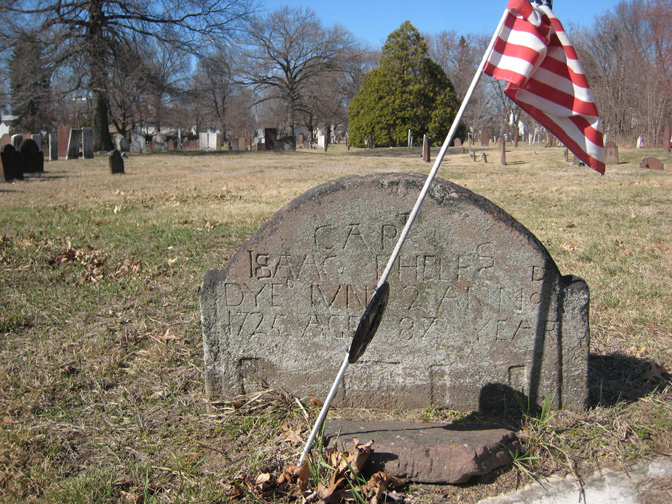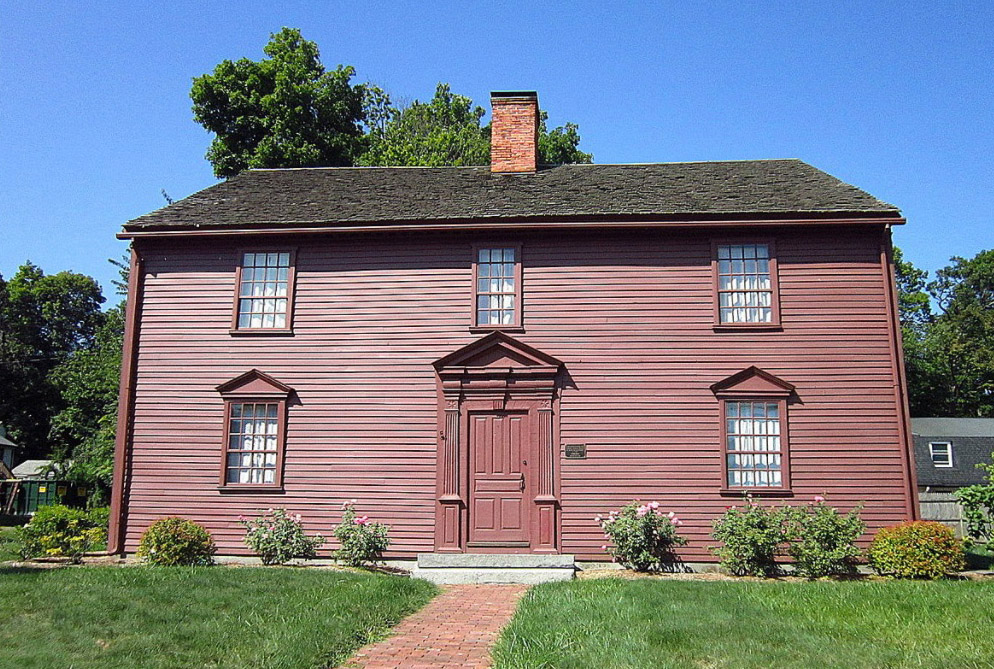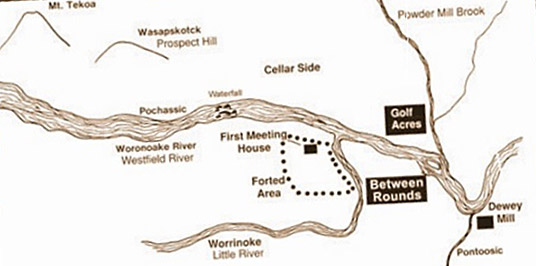
This is the fourth in a series of posts about four generations of my ancestors in colonial Massachusetts and Connecticut. It includes the Bagg, Burt, Phelps, Moseley, Stanley and other related families between 1635 and 1795.
My seven-times great grandfather Isaac Phelps (1638-1725) was like the Energizer bunny: he never seemed to stop. For much of his life, he worked hard as a farmer and he held many offices in his home town in New England, but he also became a school teacher at age 64 and was named a captain in the militia at age 71. Only death seemed to slow him down, at age 87, and his tombstone is almost as legible now as the day it was carved.
Isaac was born in 1638 in Windsor, Connecticut, the eldest son of George Phelps and Philura Randall,1 both of whom were newcomers to New England, part of a wave of Puritans who fled England, hoping to follow their religious beliefs without persecution. By the time he was nine years old, Isaac had four younger siblings, but that year, 1647, two of them died. The following April, his mother died.2 Families needed two parents to share the work of running the household and the farm, so his father did not wait long to remarry. George Phelps’ second wife was Frances Dewey, whose second husband, Thomas Dewey, had died two days before Philura.3
From age ten, Isaac grew up in what we would describe as a blended family. The household included his father and step-mother, his brother Joseph, Mary Clark (Frances’ daughter from her first marriage) and the five Dewey children, Thomas, Josiah, Anna, Israel and Jedediah. Eventually, there were three more half-brothers: Jacob, John and Nathaniel Phelps. Isaac’s other brother, Abraham, was adopted by Randall relatives who were childless.4
The Puritans wanted to be able to read the Bible themselves, so education was considered important in colonial New England. Perhaps Isaac went to a neighbour’s house for tutoring.
Meanwhile, everyone in the community attended church for the whole day every Sunday. In 1662, Isaac Phelps married Ann Gaylord.5 (See note i) Isaac’s and Ann’s eldest child, Isaac Jr., was born in 1666 in Windsor. The family moved to Westfield, Massachusetts around 1670 and the rest of their 11 children were born in that frontier settlement. (See note ii)

Ann (Gaylord) Phelps died in 1689 or 1690, when the youngest child was still a toddler. Sometime before 1694, Isaac married his neighbour, widow Mary (Newberry) Maudsley,6 who had eight children of her own. (See note iii) Once again, Isaac was part of a big, blended family.
Members of the extended Phelps/Dewey family were also living in Westfield, including George and Frances and Isaac’s half-brothers and step-siblings. Perhaps these families saw more opportunities to acquire fertile farmland in the new settlement, which was founded by settlers from nearby Springfield and a handful of families from Windsor.
Isaac and his father were amongst the first settlers in Westfield, choosing prime home lots located near the Little River in 1667.7 The colonists purchased the land from the indigenous people and Westfield was incorporated in 1669.
Because Westfield was quite isolated, the residents were afraid of attacks by the indigenous people, especially during King Phillip’s War (1675-76). When colonial authorities in Boston told the residents to go to Springfield because of the danger, Isaac Phelps was one of four people to sign a letter refusing to do so. Instead, Westfield residents built a two-square-mile wooden palisade around the town and dug an underground cellar where the women and children could hide.8 Westfield was not attacked, although Springfield was, and some individuals were.

Westfield’s citizens maintained a militia for decades to counter the threat that was fueled by ongoing wars between the English and the French and their Native American allies. In 1709, Isaac became a captain in the militia.
Westfield had about 150 residents in 1676, and the town continued to grow. The Dewey brothers built a mill on one of the many nearby creeks, there was a tavern in the town and a road that led to Springfield. Most important, the town had a minister: Reverend Edward Taylor, a graduate of Cambridge University and of Harvard University, served the people of Westfield from 1679 to 1726. Isaac was one of the founding members of the church, and a deacon.9
Isaac also played a role in Westfield’s civic life. He served as town clerk, assessor, surveyor and town treasurer,10 and, although he was not a scholar, he took on the duties of school teacher at age 64. He was also a legislator of the Massachusetts General Court.
He died in 1725 and was buried in Westfield’s Old Burying Ground. He is my ancestor through his daughter Hannah Phelps, who married Daniel Bagg in 1693.
Photo credits:
Janice Hamilton
http://thedeweyhouse.org/theDeweyHouse.org/Welcome.html
https://www.cityofwestfield.org/DocumentCenter/View/236/Westfield-History
See also:
Janice Hamilton, “George Phelps of Windsor and Westfield,” Writing Up the Ancestors, April 18, 2018, https://www.writinguptheancestors.ca/2018/04/george-phelps-of-windsor-and-westfield.html
Janice Hamilton, “A Visit to the Old Burying Ground of Westfield, Massachusetts,” Writing Up the Ancestors, April 4, 2018, https://www.writinguptheancestors.ca/2018/04/a-visit-to-old-burying-ground-of.html
Notes:
i. The Gaylord family. Ann Gaylord’s grandfather William Gaylord (also spelled Gayler, Gaylar, Gaylor, Gailead and Gailer) brought his family from England to Dorchester, Massachusetts aboard the Mary and Johnin 1630. At the time, he and his wife (name unknown) had six children ranging in age from about four to 15.11
William Gaylord played an important role in Dorchester, initially as one of two deacons of the Congregational church that the colonists and their pastor, John Warham, established there.
William was one of four men who signed early town orders in Dorchester, he was chosen as a selectman (town official) for several terms between 1635 and 1637, and he was appointed assessor in 1636. Two years later, the Gaylord family followed Rev. Warham and a number of other Dorchester families to Windsor, Connecticut. There, William was granted a 20-acre home lot and several tracts of agricultural land. He served as deputy for Windsor to the Connecticut General Court for many years. His wife died in Windsor in 1657; William Sr. died in 1673.
Their second child, William Jr., was baptized in Crewkerne, Somersetshire, in 1617, and married Anna Porter in Windsor in 1641.12 John Porter’s family had come from England and settled in Windsor in 1639. After Anna died in 1653, William married Elizabeth Drake. William Jr. died in 1656, leaving seven children, the oldest of whom was Ann, born 1645. Ann must have shouldered a lot of responsibility helping to raise her younger brothers and sisters.
She married Isaac Phelps on March 11, 1662/63.
ii. Isaac’s and Ann’s children born in Windsor:
Isaac, b. 1666, m. Mary Moseley.
Those who were baptized in Westfield were:
daughter b. 1669, d. young.
John b. 1672, married Thankful Hitchcock;
Hannah b. 1674, m. Daniel Bagg in 1693/4 (my direct ancestors);13
Hezekiah b. 1677;
Joseph b. 1679;
Daniel b. 1681, d. 1690;
Noah, b. 1684, d. 1731 at Housatonnuc;
infant, b/d 1686;
Ebenezer, b. 1687, m. Susanna Burbank.14
iii. Some 19th-century genealogies suggest Isaac did not remarry after Ann’s death, but it would have been unusual for a widower with a houseful of young children not to look for a new wife. An article proving Isaac did remarry appeared in The American Genealogist in 1993 (TAG vol. 68, p 239-241). In such a small community, there were multiple connections between some of these blended family members. After Isaac Phelps married Mary (Newberry) Maudsley, his son Isaac Jr. married her daughter, Mary Maudsley.
iv. Windsor and Westfield kept good records and these databases are available online from the New England Historic Genealogical Society. Several books have been written about the area and its residents, mostly by amateur historians and genealogists in the 19th century, and the information in these books need to be checked against the databases. Keep in mind that often several individuals living about the same time had the same name. For example, besides the father and son I have mentioned, there were three other men named Isaac Phelps. See TheNew England Historical and Genealogical Register 163 [2009]: 117.
Sources:
- Connecticut: Vital Records (The Barbour Collection), 1630-1870 (Online Database: AmericanAncestors.org, New England Historic Genealogical Society, 2011.) From original typescripts, Lucius Barnes Barbour Collection, 1928. https://www.americanancestors.org/DB414/i/12316/224/138422806, accessed April 7, 2018
- Ibid.
- Ibid.
- Oliver Seymour Phelps and Andrew T. Servin, compilers, “George Phelps the Emigrant, 1630,” The Phelps Family of America and their English Ancestors, and other interesting papers, coats of arms and valuable records, volume II (Pittsfield, MA: Eagle Publishing Company, 1899), p. 1270.
- Burton Spear, compiler, Search for the Passengers of the Mary and John, 1630, vol. 5, Gallop – Greenway (Toledo: The Mary and John Clearing House, 1987), p 18.
- The American Genealogist. New Haven, CT: D. L. Jacobus, 1937-. (Online database. AmericanAncestors.org. New England Historic Genealogical Society, 2009 – .) https://www.americanancestors.org/DB283/i/12963/239/24672606, accessed April 7, 2018.
- Rev. John H. Lockwood, Westfield and its Historic Influences 1669-1919: The Life of an Early Town (Springfield, 1922, Printed and sold by the author), p. 58, https://archive.org/stream/westfieldandits00lockgoog#page/n80/mode/2up accessed April 1, 2018
- Kay Delli Bovi, Barbara Trant, volunteers in public schools, The Westfield Story, printed in 2006, http://www.cityofwestfield.org/DocumentCenter/View/236accessed April 7, 2018.
- Lockwood, Westfield and its Historic Influences 1669-1919, p. 94. https://archive.org/stream/westfieldandits00lockgoog#page/n120/mode/2up, accessed April 1, 2018.
- Phelps and Servin, The Phelps Family of America and their English Ancestors, p. 1269.
- Robert Charles Anderson, The Great Migration Begins, Immigrants to New England, 1620-1633, 3 volumes, (Boston: New England Historic Genealogical Society), II: 742.
- Connecticut: Vital Records (The Barbour Collection), 1630-1870 (Online Database: AmericanAncestors.org, New England Historic Genealogical Society, 2011.) From original typescripts, Lucius Barnes Barbour Collection, 1928. https://www.americanancestors.org/DB414/r/138416737, accessed April 10, 2018.
- New England Marriages to 1700. (Online database. AmericanAncestors.org. New England Historic Genealogical Society, 2008.) Originally published as: New England Marriages Prior to 1700. Boston, Mass.: New England Historic Genealogical Society, 2015. https://www.americanancestors.org/DB1568/r/426875386, accessed April 10, 2018.
- The New England Historical and Genealogical Register. Boston, MA: New England Historic Genealogical Society, 1847-. (Online database: AmericanAncestors.org, New England Historic Genealogical Society, 2001-2013.) https://www.americanancestors.org/DB202/r/245392558, accessed April 10, 2018.
